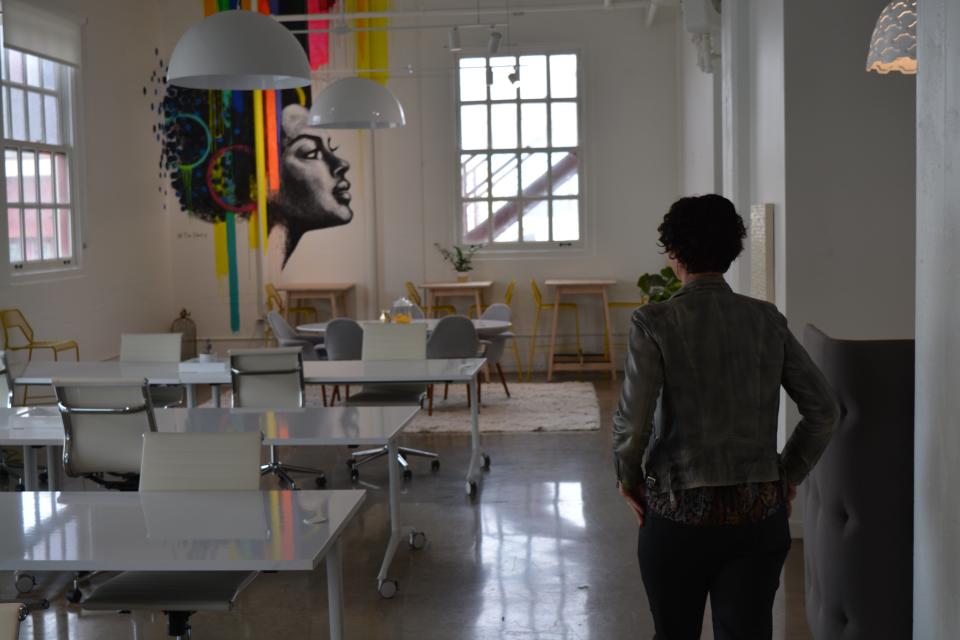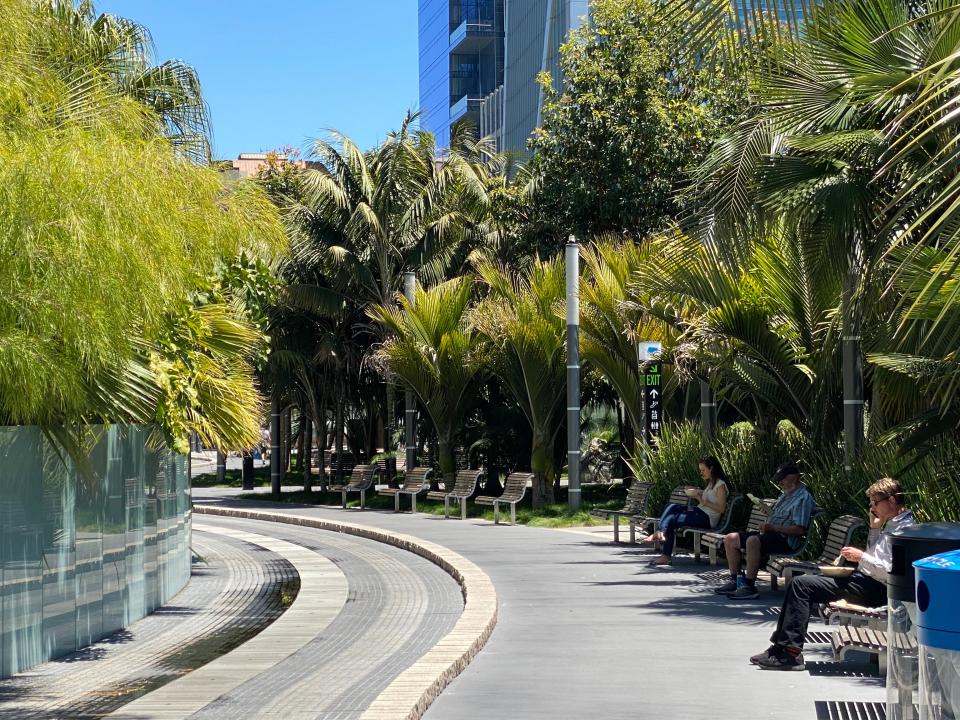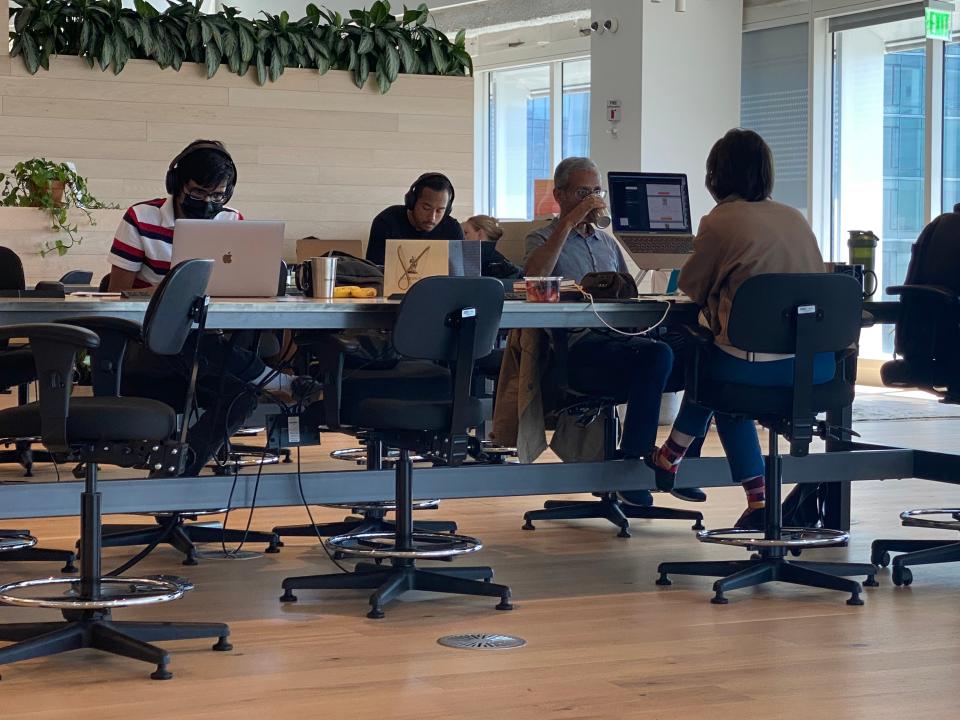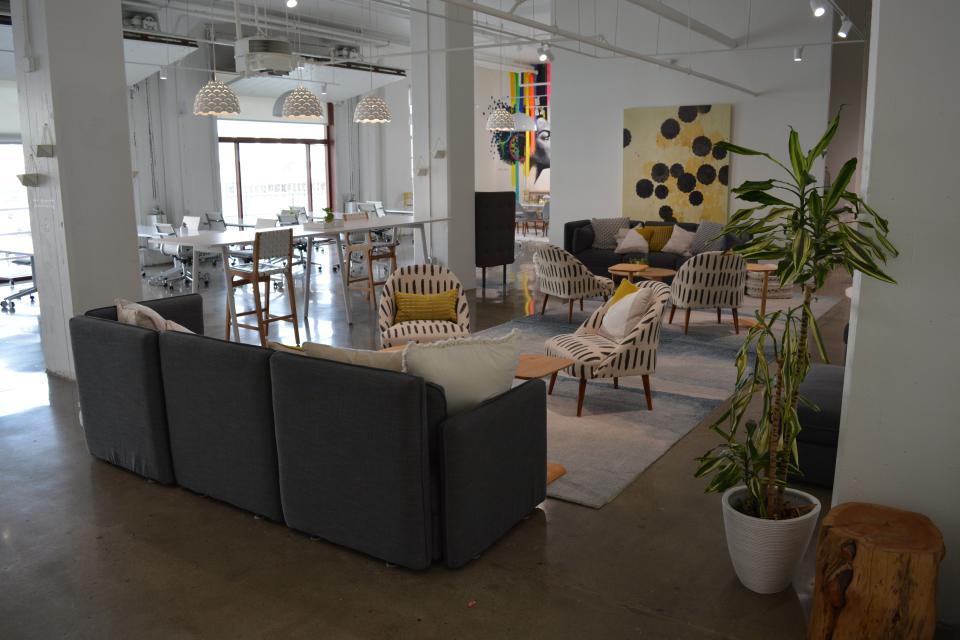Let them drink kombucha: San Francisco’s lavish tech offices return as city still struggles

In a coworking space on the 37th floor of the Salesforce Tower, a $1 billion, cheese-grater shaped skyscraper that looms over the San Francisco skyline, a very particular segment of life in the tech capital has returned.
During a visit in mid-June, the kombucha on tap was flowing. Workers with laptops, smart watches, expensive haircuts and even more expensive trail-running shoes pounded away at code, chatting on calls in English, Spanish, and Swedish. Vendors set up a “pop-up market” selling cacti and Instagram-friendly pottery in a lounge. Some were masked, some were not. Pillows were printed with diagrams encouraging social distancing.
Outside, a heat wave was hammering the drought-parched state and straining the power grid, but up in the sky, the air conditioning was crisp, the view of the bay excellent. Rooftop gardens and pools gleamed like gems fixed in the grey lattice of the city below. From there, I could no longer make out the unhoused person I passed on the way in, holding a sign in front of stopped traffic at a nearby intersection that read, “We are struggling one day to another. Anything helps”.
A parking attendant, still working inside a pandemic-era booth constructed from a papal amount of plexiglass, said, “Slowly, it’s coming back to life”. At least, this gilded strata of San Francisco life was.
Since California fully reopened on 15 June, and even before, tech workers in San Francisco have been eagerly returning to the lavish office spaces top firms use to attract talent. Their jobs, fantastically profitable and easier than most to do remotely, have remained intact, and now they can get back to the digital good life IRL.

For the rest of the city, where homelessness was raging even before the combination pandemic-recession, where rental assistance has been slow to reach average people, and where housing was already deeply unattainable for many, things have been far less rosy.
Inside the shared office, though, many seemed thrilled about the coming days.
“It’s nice to see people,” said Gang, who works for a language-learning company and asked to use only his first name. “It’s really nice to see people, see their smiles, work in person. There’s some work that’s just better to do in person. A lot of collaboration, brainstorming, happens more efficiently in person. We’ve definitely missed that over the last year. It’s been nice.”
For Mats Andersson, a former software engineer now at the Swedish-American Chamber of Commerce, the return had a few cons, and some major pros.
“There are aspects of [working from home] that were fantastic. We could connect with so many people in one day. Your geographical boundaries were kind of broken down,” he said, adding, however, “I have a small young daughter, five years old. In the beginning we were fighting in our room for space. People without kids can’t imagine what this has been like.”

For a time, it seemed like the pandemic was threatening to partially blow up even the Midas-touched tech industry.
At the end of the first quarter in 2021, 9.7 million square feet of commercial office space, or 40 per cent of all available commercial space, was vacant, compared to 3 million in late 2019, according to real estate firm Avison Young, approaching levels not seen since 2005 after the dot-com collapse. Companies like Pinterest, Salesforce, Dropbox, Uber, and PayPal all took nearly a billion in lease-related write-downs or pulled out of office space agreements.
Many of San Francisco’s tech workers, who both live in and have had a hand in creating the single most expensive housing market in the country, fled the city for the suburbs, or other cities like Austin, Texas, and Denver, Colorado.
But now, the state is back open, and these people are flocking back to the office, as well as co-working spaces like WeWork, which are well-positioned to capitalise on a moment when flexible work arrangements are the most many are comfortable with.
“We’ve always thought about flexibility in everything that we did as a company. It just became more relevant in the macro-environment in the world. Now we are at the forefront of that conversation,” Elton Kwok, the company’s territory vice-president managing the California region, told The Independent. “Every time there is another milestone in terms of Covid increasingly getting better, we see a very dramatic spike in bookings, sales, people coming back to work.”
The city has thrown its weight behind this model as well. On Tuesday, it announced a partnership with WeWork to incentivise businesses to rent out office space.
At Facebook, half of whose global workforce is based in the Bay Area, select offices are already open at a 10 per cent capacity, with a full re-opening slated for the fall, according to a spokesperson. Twitter is re-opening its San Francisco office, which features a rooftop sundeck, in-cafeteria greenhouse, and full-scale recreation of a Montana mountain lodge, at 50 per cent to vaccinated employees starting on 12 July, a company official told The Independent.
Others, like employees of Airbnb, have the dual perk of offices re-opening, without the expectation that they work there most days.
“I told our employees they don’t have to come back to the office until next September. We’re going to allow a lot of flexibility,” CEO Brian Chesky said on a May earnings call. “And even when we do ask people to come back, they’re going to have a lot more flexibility than before. People aren’t going to be expected to come back to the office five days a week, every week. We think that is really not how most workplaces in the 21st century are going to operate.”
Still, the pandemic has been challenging for some in this space; small business owners in an industry dependent on in-person interaction. Not everyone has the financial warchest of a WeWork, which has received at least $18.5 billion in investments from its main backer, SoftBank.
For Grace Kraaijvanger, a former professional dancer and founder of a co-working space called The Hivery, focused on the arts and female empowerment, the year began on a high. They’d just opened a second space the previous November in an airy office on the piers of San Francisco’s Fort Mason, and First Lady Jill Biden visited in February during the 2020 presidential campaign.
Then, the pandemic hit. Unlike many new tech-adjacent companies in the Bay, they don’t have any venture capital funding, and they laid off employees as their two locations were shuttered for 15 months straight.
“The pandemic put us in a situation that was the antithesis of what we’re about,” she said, her voice echoing through the empty facility and its stylish conference rooms and lounge areas, some still filled with stacked chairs. It re-opens in early July. “An empty space with no people, no gathering, no energy, that’s the opposite of everything we believe in.”
A combination of government aid, new business strategies like virtual courses, and “fighting like hell” allowed The Hivery to stay in business “by a thread”, according to Ms Kraaijvanger. Her members, many of them women juggling work and family caretaking, were equally strained.
“The impact on parents, working parents was profound,” she said. “It completely shifted the way that we look at society and our capacity to work and raise children at the same time in the same space when there’s no childcare available. I know that very fact made work impossible for people, either put them out of work or out of business.”

And that’s among people working in the digital world who can afford to pay for extra workspace outside of housing. The pandemic was even more devastating towards low-wage workers in the hard-hit service industries, who are often women of colour.
These struggles were just one manifestation of the economic devastation the pandemic brought to the city. The tech industry still soared – netting a record $46 billion in venture capital funding in San Francisco and Silicon Valley in 2020, and more than $10 trillion in new market capitalisation for Bay Area-based firms – while San Francisco’s already deeply unequal economy became further stratified.
Renters in San Francisco have applied for more than $13 million in city rental assistance under a new programme, according to the mayor’s office, and, as of March, even though rents plunged more than 20 per cent compared to last year, the median one bedroom apartment in the city was still the nation’s most expensive, at $2650-a-month. Previous aide programmes, like billions in housing assistance from the state, have been slow to go out to renters, with one analysis finding that the initiative, called Housing Is Key, distributed money to just 2 per cent of applicants between March and June.
And that’s just for those who do have homes. There are more than 8,000 unhoused people in the city, which advocates say is likely a massive undercount, and the number without homes still vastly outpaces the city’s shelter capacity, though mayor London Breed, who has ushered through huge amounts of aid money in a short period, plans to spend $1 billion tackling homelessness in the coming over the next two years.
The city also voted this week to extended the eviction moratorium until the end of the year, but the pandemic has revealed disparities in San Francisco that will take much longer than six months to heal.
Read More
Windows 11: Everything Microsoft is promising from the operating system nobody expected
Windows 11 - live: Microsoft’s new ‘next generation’ operating system unveiled today
WeWork CEO sparks backlash after claiming workers who want to return to offices are most ‘engaged’
San Francisco to make vaccine mandatory for all workers
The backstreet San Francisco tech firm that triggered a worldwide internet freakout

 Yahoo Finance
Yahoo Finance 